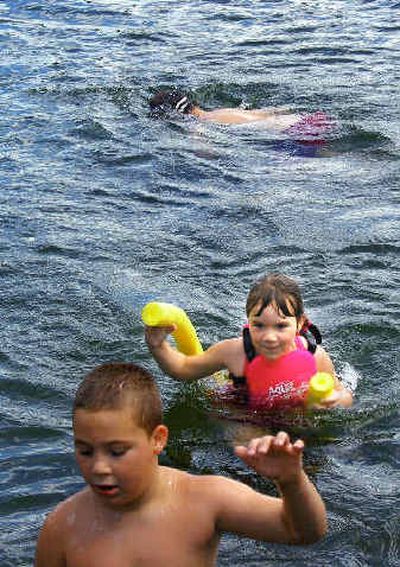Swimmers getting the itch at lakes

The sky was slightly overcast, but the 85-plus-degree day at Bear Lake was perfect for 5-year-old Billyann Davis to challenge her brothers to a water fight.
Schistosome dermatitis, or swimmers’ itch, was the furthest thing from their minds.
Jessica Davis, Billyann’s mom, has been bringing her children to swim at the lake, one mile north of Chattaroy, for years. She said she knows the lake has had problems with swimmers’ itch, but they’ve taken the suggested precautions and have never had to deal with it.
Pam Erickson’s son wasn’t as lucky. After swimming at Bear Lake, he began to experience burning and itching on his arms and legs. He was covered with red dots that looked like chicken pox.
His inflamed skin itched intensely, and when his mom took him to the doctor, the California transplant didn’t know what it was.
Erickson used an antihistamine cream to relieve the irritation.
“It took about a week to go away,” said Erickson. She called her son’s Sunday school to alert it that the children may have been exposed to chicken pox.
According to Julie Graham of the Spokane Regional Health District, swimmers’ itch is a nonreportable disease, and it’s not tracked by district epidemiologists. But the Health District does receive calls every year, usually later in the summer, when things really heat up.
Schistosome dermatitis is caused by the larva of a small aquatic parasite that exists in water fowl such as ducks and geese, as well as animals like beaver and muskrats.
The parasites are excreted into the water through the bird’s or animal’s feces. The eggs then hatch into larval forms that swim about in search of the usual, secondary host, an aquatic snail. From there it develops and emerges as a slightly larger, free swimming form.
Humans aren’t natural hosts for the larvae but may become involved when swimming in infected water.
This doesn’t mean that the lake is polluted. In fact, just the opposite is probably true.
Natural lake conditions promote the diversity of species, including the birds and snails that are potential hosts for swimmers’ itch.
Bear Lake and its park are managed by the Spokane County Parks and Recreation Department. Randy Johnson has been with the department for 13 years. Over the years, swimmers’ itch has been an ongoing problem at several area lakes.
Johnson said that for the first time in about four or five years there have been recent reports of swimmers’ itch at Liberty Lake. Fish Lake has also been known to have occurrences.
Lakes and ponds with an abundance of water fowl, snails and water weeds have the greatest concentration.
The county Parks Department has placed a sign near the swimming area at Bear Lake to alert people of the potential problem. An advisory is posted beneath the sign to let people know that pamphlets from the Health District with information on swimmers’ itch are available at the cashier’s booth.
An outdoor shower, near the lifeguard station, is available so swimmers can rinse off after swimming. Park employees are instructed on how to properly remove and dispose of bird feces from docks, paths and areas near the beach.
Johnson believes that some people are just more susceptible to swimmers’ itch, even with the same behavior. Some people that have put on sunscreen prior to swimming seem to fewer problems, but Johnson isn’t sure why.
The most important thing you can do is to towel off vigorously immediately after leaving the water. It’s during the evaporation process that the parasites dig into your skin. Showers are recommended, and swimmers are encouraged to stay within the designated swim areas.
Treat the itching with an application of calamine lotion and antihistamines like Benadryl.
With a little precaution, area swimmers won’t be beached this summer.